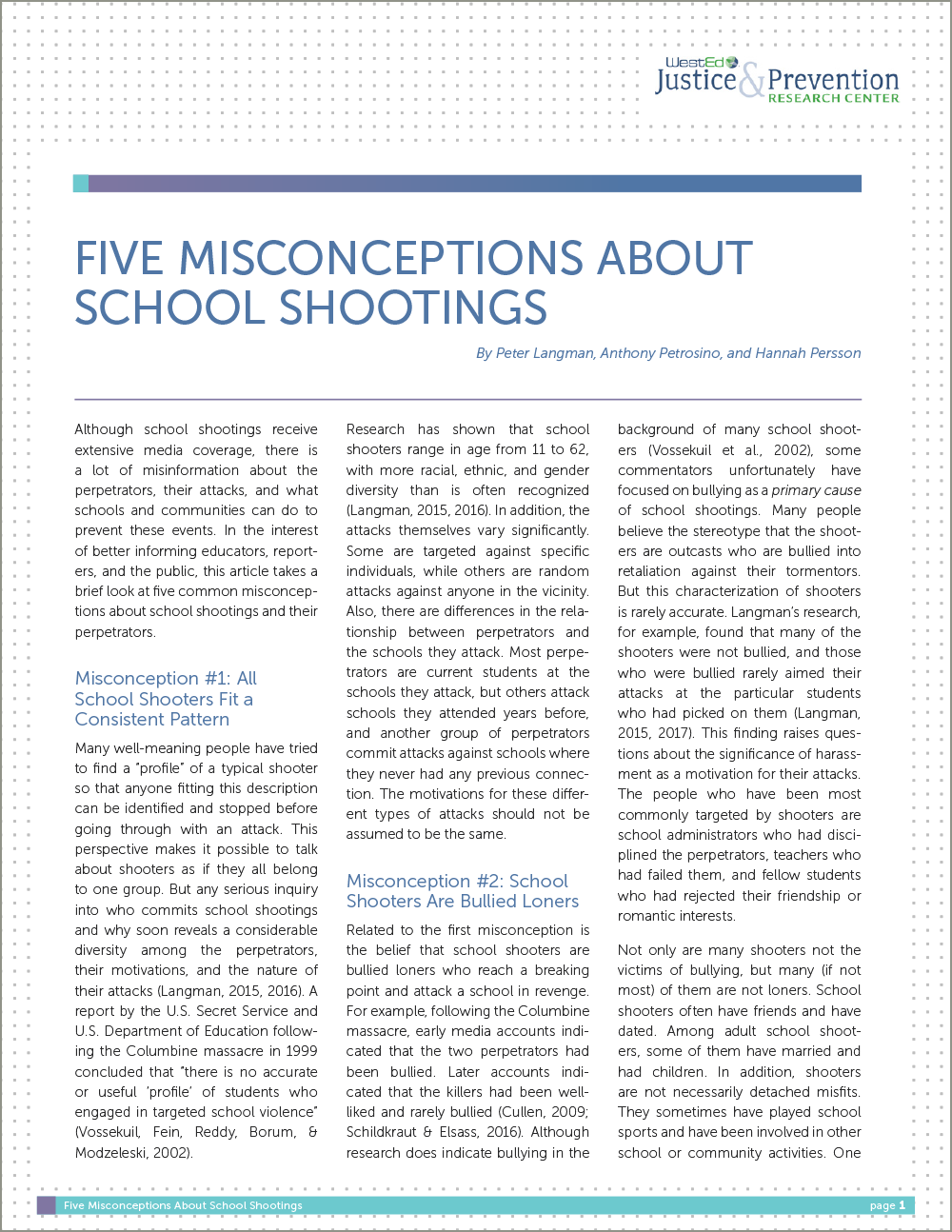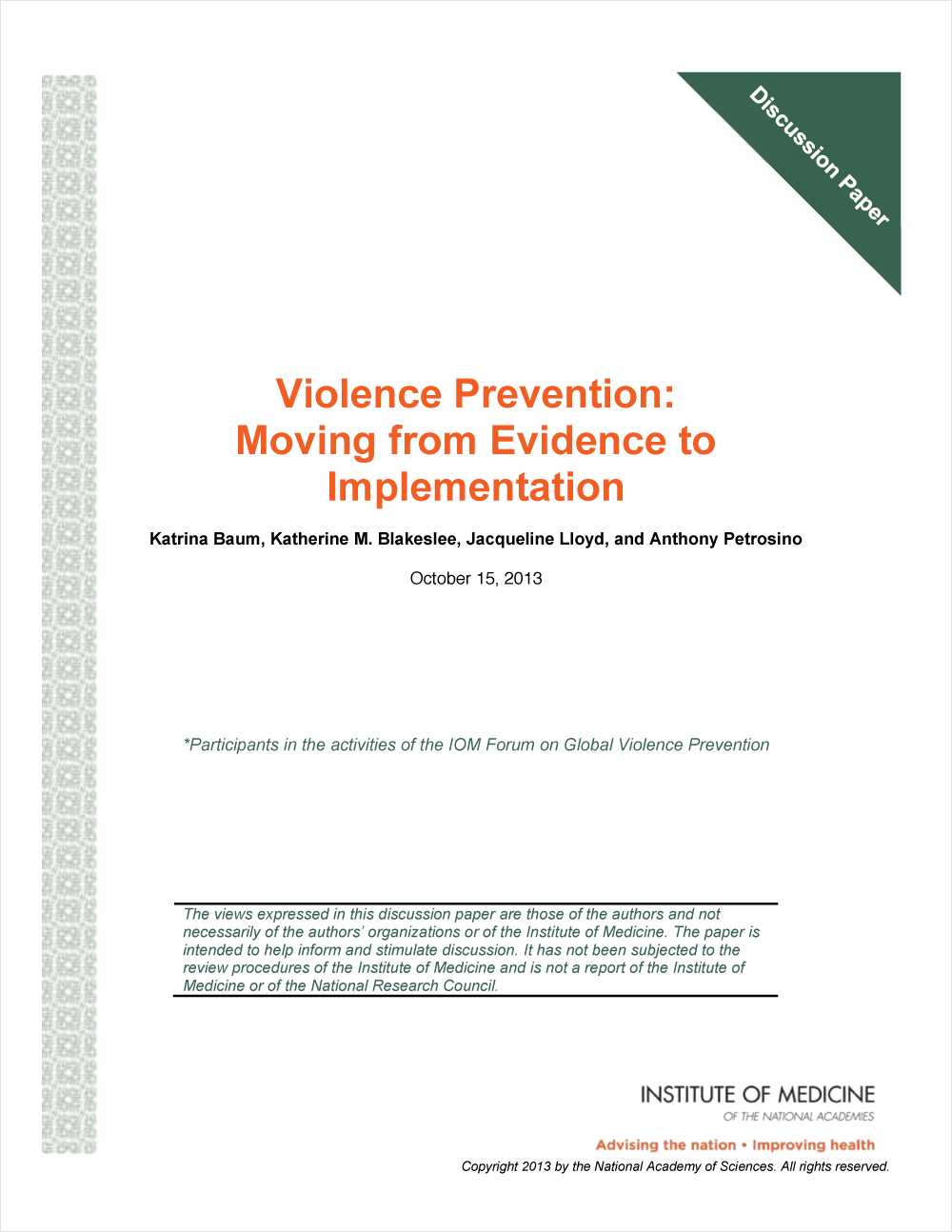Interview with Dr. Peter Langman: Strategies for Preventing School Shootings
Posted on

By Danielle Munguia, Research Assistant with the WestEd Justice & Prevention Research Center (JPRC) and JPRC Director Anthony Petrosino. This interview first appeared in the JPRC newsletter and is posted here with permission.
Please note: This blog post mentions issues related to incidents of gun violence in school settings.
The shooting last November at a high school in Oxford, Michigan, which killed four students, again raised alarms about the safety of students and staff in schools. Although shootings at schools that result in a homicide are statistically rare events, that brings no comfort to the families and communities that experience them. Schools legally operate “in loco parentis” (in place of parents) and have legal and ethical responsibilities to protect the children who have been entrusted to them. But a critical policy question to answer is, what should schools do to ensure such protection?
To help inform policy, the JPRC asked Dr. Peter Langman, one of the nation’s foremost experts on school shootings and the psychological struggles of mass violence perpetrators, to respond to this and related questions. Langman is the Director of Research and School Safety Training at Drift Net Securities and a researcher with the U.S. Secret Service’s National Threat Assessment Center. He has written three books on school shootings, including Warning Signs: Identifying School Shooters Before They Strike (2021). Langman is also the lead author on the JPRC publication Five Misconceptions About School Shootings.
What are the most important warning signs to notice when identifying a potential school shooter?
Warning signs take many forms and can show up in multiple places—conversation with peers, comments to intended victims, social media posts, and even homework assignments. In addition, warning signs can be explicit or implied. The danger with explicit warning signs is that they are so obvious that people may not take them seriously. The danger with subtle warning signs is that people don’t “read between the lines” to see the implied message.
One category of warning signs is “leakage,” meaning that the perpetrators leak their intentions to someone else. Explicit leakage includes announcements to peers of the impending attack, direct statements to intended victims that they are going to be killed, and invitations to peers to join the attack. Less direct leakage includes comments that “something bad is going to happen,” or warning friends not to go to school on a certain day.
Another category of warning signs is called “attack-related behavior.” This refers to any action that indicates the person is preparing for an attack. The significance of this is that the person is not just thinking about committing violence but is taking specific steps to make it happen. Attack-related behaviors include making a hit list; obtaining weapons; practicing with the weapons; planning the day, time, and place of the attack; considering how to get the weapons inside the building; and so on.
Another concept is what I call “evidence of imminence.” This means that not all warning signs are equally concerning. Vague or unrealistic plans present a less imminent danger than detailed, achievable plans. For example, a student who says, “Sometimes I just feel like blowing up the whole town or getting a gun from somewhere and going on a rampage,” may be concerning but does not present an imminent threat. In contrast, a student who says, “I stole my father’s shotgun and next Monday morning I’m getting my revenge in the school lobby,” presents a clear, imminent danger.
Is there a specific profile for a school shooter, and does a psychological predisposition play a role in their development?
There is no profile of a school shooter—there is a great deal of diversity in demographics, family background, social involvement, and academic achievement.
There is diversity not only among school shooters but also among school shootings. Some perpetrators seek out and kill specific people—family, students, and/or staff—whom they believe mistreated them. These attacks tend to be smaller scale. The larger-scale attacks—the ones we hear the most about, such as those committed at Columbine High School, Virginia Tech University, Sandy Hook Elementary School, and the Parkland, Florida, high school—are random attacks. In these incidents, there are no specific intended victims—the perpetrators just want to kill as many people as possible. Some incidents combine one or more targeted victims with random victims. To make sense of school shootings, we need to recognize that different types of attacks tend to have different contributing factors and motivations.
Despite the diversity of attacks and attackers, there are patterns among the perpetrators. Based on my research, they typically fall into one (and sometimes two) of three categories: psychopathic, psychotic, and traumatized. Psychopathic shooters are narcissistic, callous, and sadistic. They can be charming and deceptive or abrasive and belligerent. Either way, they are cold-blooded killers. Psychotic shooters suffer from schizophrenia or schizotypal personality disorder. They may have full-blown hallucinations and delusions or be paranoid and have difficulty knowing what is real and what isn’t, but not experience the same level of psychosis as those with schizophrenia.
Whereas psychopathic and psychotic shooters typically come from essentially stable, intact families, traumatized shooters grow up in chronically and severely dysfunctional homes. Their parents have histories of criminal behavior, substance abuse, and domestic violence. The traumatized shooters grow up with physical abuse, emotional abuse, and sometimes sexual abuse.
Most people who are psychopathic, psychotic, or traumatized, however, do not commit murder. Thus, these psychological factors must combine with other factors to put someone on the pathway to violence. These other factors can include a biological predisposition to violence, family dynamics, social stressors, and cultural influences.
How should school personnel, parents, and students respond to individuals who make serious threats about school shootings?
Warning signs need to be reported to school administrators. They can also be reported to the local police as well as the nearest office of the FBI or Secret Service.
Are there proactive methods schools can take to prevent school shootings?
Schools in the United States have focused on implementing measures such as lockdown drills and trainings on how to survive an attack by an active shooter. Though these may save lives, they do not prevent school shootings. They are reactive, not proactive.
The best practice for preventing school shootings is for schools to have trained threat assessment teams in place. A threat assessment team is a multidisciplinary group of school personnel who receive training in investigating safety concerns. The threat assessment process consists of identifying and responding to warning signs, differentiating real threats from false alarms, and intervening before there is a shooter in the building.
It is important to note that threat assessment is not focused on punishing students or criminalizing their behavior. Some communities have been resistant to having threat assessment implemented in their schools because they fear that it will have a negative impact on the students.
But effectively implemented threat assessment has been shown to decrease suspensions, expulsions, and arrests by providing guidelines for investigating and assessing student behavior. The goal of threat assessment is to identify students in crisis and provide the services and supports necessary to get them out of crisis and off the pathway to violence.
What are the research gaps that the JPRC and other research groups need to address?
As just noted, some communities object to having threat assessment implemented in their schools. It would be helpful to explore in more detail the nature of this objection and how best to work with such communities to maximize school safety. [Note: The JPRC is currently conducting a study funded by the U.S. National Institute of Justice to evaluate Behavioral Threat Assessment in Texas. Study findings, as they become available, will be summarized in a future JPRC Update.]
Similarly, even with threat assessment teams in place, they cannot do their job if people don’t report the warning signs they encounter. In many cases, students, staff, or family members had information that could have been used to prevent an impending attack but did not report what they knew. We need to find ways to increase the reporting of warning signs. That would be a big step forward in keeping our schools and communities safe.
Additional Resources
- Five Misconceptions About School Shootings (Publication)
- WestEd Researchers Examine Policy Responses to School Tragedies (Journal)
- Improving School Safety: Policy Trends, Assessment, and Prevention (Webinar)
About the WestEd Justice & Prevention Research Center
The WestEd Justice & Prevention Research Center (JPRC) conducts and disseminates research and evaluation to address crime, violence, and injustice. A primary goal of the Center is to become a trusted source of evidence on the effects of policies and programs in areas such as violence prevention, juvenile and adult justice, school safety, and public health.
Keep current on the latest JPRC reports, research studies, projects, events, and news by subscribing to our newsletter, visiting the JPRC website, or emailing Anthony Petrosino, Director of JPRC, at apetros@WestEd.org.



